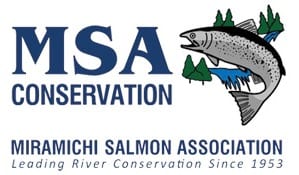Smolt-to-Adult Rearing Study Initiated
 The crisis over poor adult salmon returns in the past few years has generated a lot of attention and we are all trying to come up with the solutions that will see large numbers of salmon in our rivers again. The MSA has been meeting with other organizations and individuals to share ideas about the best path forward. Although we look to the federal government to lead this recovery, there are things that we can do to help and one of the options the MSA has available is using its hatchery facility to stock more salmon.
The crisis over poor adult salmon returns in the past few years has generated a lot of attention and we are all trying to come up with the solutions that will see large numbers of salmon in our rivers again. The MSA has been meeting with other organizations and individuals to share ideas about the best path forward. Although we look to the federal government to lead this recovery, there are things that we can do to help and one of the options the MSA has available is using its hatchery facility to stock more salmon.
In this regard, the MSA began regularly meeting with University professors, industry representatives, other conservation groups, and of course government officials as well. A loose coalition ensued and after months of meeting and referring to itself as “the group”, the acronym CAST (Collaboration for Atlantic Salmon Tomorrow) was agreed upon. It was during those recent meetings that we began to explore and discuss the best stocking strategies to recover salmon stocks on the Miramichi. Our collective conclusion was that the most effective stocking strategy would be to collect wild smolts, raise them in captivity until almost ready to spawn as adults and release them to travel up the river to the area they were born. They would be able to select their own mate and reproduce naturally. Some of the best salmon geneticists and research scientists were consulted on this strategy before coming to this conclusion. This technique has been used in the Bay of Fundy and at DFO’s Mactaquac hatchery in salmon gene-banking programs with some positive results and those programs are now being expanded.
The ultimate success of the smolt-to-adult rearing strategy hasn’t been fully proven yet and there are several scientific questions that need to be answered. This is where the CAST group has already played a significant role. With financial help from the industry partners and scientific help from the university partners, the MSA applied for a permit to collect 1,500 wild smolts from the NW Watershed in May 2015 and will grow the young salmon until they sexually mature, some as grilse in 2016 and some as large salmon in 2017. Eleven hundred smolts were collected from the LSW Miramichi, 200 smolts from the NW Miramichi and 200 smolts from the Sevogle for release in the lower NW Miramichi to supplement natural spawning. The permit was issued for the collection by DFO, but it is tentative, subject to an international review of this stocking strategy to assess the risks and benefits before a permit will be issued for the release of the fish. This review is expected during the winter of 2016 and MSA is supportive of this process. If the smolts were permitted to make their natural journey to the ocean and back, between 95 and 97 percent would perish, compared to less than 5 percent at the hatchery, so the gains are impressive. In 2014, there were only 1,235 large salmon and 1,240 grilse returning to the Northwest Miramichi, so adding 1,500 more would make a significant difference. Part of the research will be to obtain a genetic signature for each adult salmon to determine who the parents are from the resulting fry, placing transmitters on a portion of the adults to ensure they go back to the tributary of origin, monitor the spawning process to determine if the hatchery-reared adults were mating with the wild adults and monitoring the survival of the juveniles.
If the DFO Science review is positive and stocks continue to remain below spawning escapement, this technique could be expanded, but will require an upgrade to our hatchery facility to accommodate thousands of adult fish. Some of the advantages of this program are that smolts are collected for the hatchery breeding program instead of adults; the fish, not the hatchery manager, select their spawning mate; the smolts have survived the rigors of the wild river environment for 2 or 3 years and will be able to home in on their place of birth, and this program provides better gains in egg deposition during a time of low marine survival rates to the adult stage. Look for updates in coming MSA e-newsletters.
Historical Atlantic Salmon Returns to Miramichi River 1971-2014
Historical Atlantic Salmon Returns to North America 1971-2013
Giv’er Miramichi is about “What’s up, what’s new, what’s happening”. We are focused on building people up, supporting one another and celebrating our successes.


